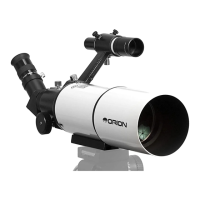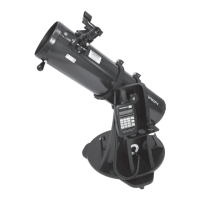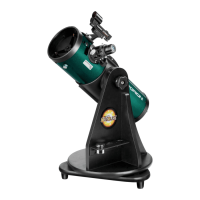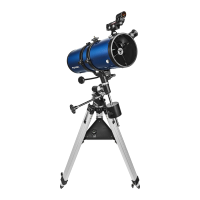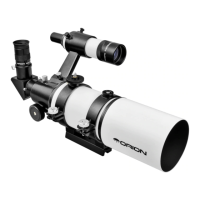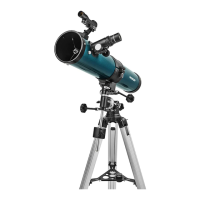Do you have a question about the Orion StarMax 90 and is the answer not in the manual?
Essential safety warnings for telescope operation and handling of optics.
General description of the tabletop telescope's capabilities and intended use.
Details the adjustable focal length, magnification range, and eye cup features.
Describes the primary optical components like the corrector plate and mirrors.
Explains how to adjust the tension for smooth up/down telescope movement.
Describes the stable wooden base that allows horizontal and vertical movement.
Details the non-magnifying aiming device that uses a red dot.
Used to position the telescope tube for balance and storage.
Allows a comfortable viewing angle and corrects image orientation.
Controls the spacing of optical components for achieving sharp focus.
Step-by-step instructions for safely removing the telescope from its packaging.
Guidance on finding an observing spot and positioning the telescope.
Instructions on telescope movement, tension adjustment, and achieving sharp focus.
How to use the reflex sight for accurate aiming of celestial objects.
Steps to align the red dot finder with the main telescope optics for accurate targeting.
Instructions for replacing the battery in the EZ Finder II reflex sight.
Advice on selecting locations away from light pollution and obstructions.
Explains atmospheric conditions affecting viewing quality and clarity.
How to keep objects centered due to Earth's rotation during observation.
Discusses the optimal magnification range for the telescope's aperture.
Describes the types of celestial objects visible and their appearance.
Details on viewing the Moon, its craters, and phases for maximum detail.
Guide to observing Jupiter, Saturn, Venus, and Mars with details on features.
Tips for observing star colors, double stars, and star patterns.
Information on viewing nebulae, star clusters, and galaxies.
General advice and recommended techniques for amateur astronomy.
Discusses the impact of light pollution on observations and mitigation strategies.
Advice for users who wear glasses, focusing on eye relief and image clarity.
Links and information regarding Jupiter's moon positions and events.
Resources for sky navigation, star charts, and astronomy software.
Details on observing specific notable stars like Alberio, Mizar, and Antares.
Guide to finding and viewing the M44 star cluster.
Instructions for finding and viewing the M57 Ring Nebula in Lyra.
Information on observing the M13 globular cluster in Hercules.
Guide to viewing the bright M42 Orion Nebula and its associated stars.
Essential safety warnings for telescope operation and handling of optics.
General description of the tabletop telescope's capabilities and intended use.
Details the adjustable focal length, magnification range, and eye cup features.
Describes the primary optical components like the corrector plate and mirrors.
Explains how to adjust the tension for smooth up/down telescope movement.
Describes the stable wooden base that allows horizontal and vertical movement.
Details the non-magnifying aiming device that uses a red dot.
Used to position the telescope tube for balance and storage.
Allows a comfortable viewing angle and corrects image orientation.
Controls the spacing of optical components for achieving sharp focus.
Step-by-step instructions for safely removing the telescope from its packaging.
Guidance on finding an observing spot and positioning the telescope.
Instructions on telescope movement, tension adjustment, and achieving sharp focus.
How to use the reflex sight for accurate aiming of celestial objects.
Steps to align the red dot finder with the main telescope optics for accurate targeting.
Instructions for replacing the battery in the EZ Finder II reflex sight.
Advice on selecting locations away from light pollution and obstructions.
Explains atmospheric conditions affecting viewing quality and clarity.
How to keep objects centered due to Earth's rotation during observation.
Discusses the optimal magnification range for the telescope's aperture.
Describes the types of celestial objects visible and their appearance.
Details on viewing the Moon, its craters, and phases for maximum detail.
Guide to observing Jupiter, Saturn, Venus, and Mars with details on features.
Tips for observing star colors, double stars, and star patterns.
Information on viewing nebulae, star clusters, and galaxies.
General advice and recommended techniques for amateur astronomy.
Discusses the impact of light pollution on observations and mitigation strategies.
Advice for users who wear glasses, focusing on eye relief and image clarity.
Links and information regarding Jupiter's moon positions and events.
Resources for sky navigation, star charts, and astronomy software.
Details on observing specific notable stars like Alberio, Mizar, and Antares.
Guide to finding and viewing the M44 star cluster.
Instructions for finding and viewing the M57 Ring Nebula in Lyra.
Information on observing the M13 globular cluster in Hercules.
Guide to viewing the bright M42 Orion Nebula and its associated stars.
| Optical Design | Maksutov-Cassegrain |
|---|---|
| Aperture | 90 mm |
| Focal Length | 1250 mm |
| Focal Ratio | f/13.9 |
| Mount Type | Altazimuth |
| Tripod | Aluminum |
| Finderscope | Red Dot |
| Eyepieces | 25mm |

